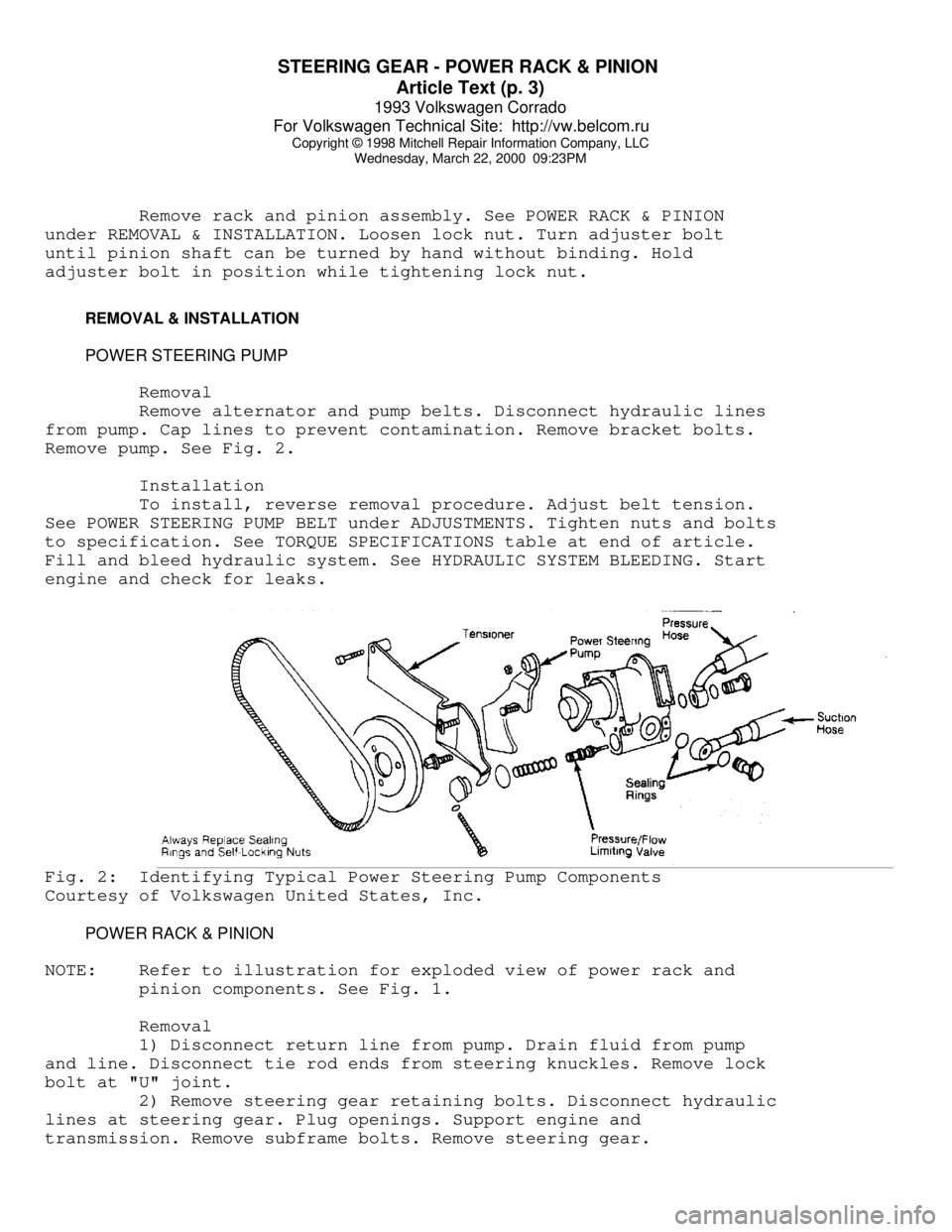1993 VOLKSWAGEN CORRADO air bleeding
[x] Cancel search: air bleedingPage 409 of 920

ANTI-LOCK BRAKE SAFETY PRECAUTIONS
Article Text
1993 Volkswagen Corrado
For Volkswagen Technical Site: http://vw.belcom.ru
Copyright © 1998 Mitchell Repair Information Company, LLC
Wednesday, March 22, 2000 08:57PM
ARTICLE BEGINNING
GENERAL INFORMATION
Anti-Lock Brake Safety Precautions
* PLEASE READ THIS FIRST *
This article is intended for general information purposes
only. This information may not apply to all makes and models. If
vehicle is equipped with Anti-Lock Brake System (ABS), refer to
appropriate ANTI-LOCK BRAKE SYSTEM article in the BRAKES section for
description, operation, depressurizing, testing, system bleeding,
trouble shooting and servicing of specific system.
WARNING: Failure to depressurize ABS could lead to physical injury.
ANTI-LOCK BRAKE SAFETY PRECAUTIONS
WARNING: Failure to depressurize ABS could lead to physical injury.
* NEVER open a bleeder valve or loosen a hydraulic line
while ABS is pressurized.
* NEVER disconnect or reconnect any electrical connectors
while ignition is on. Damage to ABS control unit may result.
* DO NOT attempt to bleed hyudarulic system without first
referring to the appropriate ANTI-LOCK BRAKE SYSTEM article
in the BRAKES section.
* Only use specially designed brake hoses/lines on ABS equipped
vehicles.
* DO NOT tap on speed sensor components (sensor, sensor rings).
Sensor rings must be pressed into hubs, NOT hammered into
hubs. Striking these components can cause demagnetization or
a loss of polarization, affecting the accuracy of the speed
signal returning to the ABS control unit.
* DO NOT mix tire sizes. Increasing the width, as long as tires
remain close to the original diameter, is acceptable. Rolling
diameter must be identical for all 4 tires. Some
manufacturers recommend tires of the same brand, style and
type. Failure to follow this precaution may cause inaccurate
wheel speed readings.
* DO NOT contaminate speed sensor components with grease. Only
use recommended coating, when system calls for an
anti-corrosion coating.
* When speed sensor components have been removed, ALWAYS check
sensor-to-ring air gaps when applicable. These specifications
can be found in each appropriate article.
* ONLY use rocommended brake fluids. DO NOT use silicone brake
fluids in an ABS equipped vehicle.
* When instlling transmittion devices (CB's, telephones, etc.)
on ABS equipped vehicles, DO NOT locate the antenna near the
ABS control unit (or any control unit).
Page 412 of 920

ANTI-LOCK BRAKE SYSTEM
Article Text (p. 2)
1993 Volkswagen Corrado
For Volkswagen Technical Site: http://vw.belcom.ru
Copyright © 1998 Mitchell Repair Information Company, LLC
Wednesday, March 22, 2000 08:57PM
to protect the hydraulic modulator and ECU.
NOTE: For more brake system information, see BRAKE SYSTEM
article in the BRAKES section.
OPERATION
When pressure is applied to brake pedal, ECU monitors input
signals from each wheel speed sensor. If ECU measures a rate of
reduction greater than what is programmed in ECU, the ECU will output
a signal to appropriate solenoid valve. Each solenoid valve allows
hydraulic pressure to increase or decrease to the appropriate wheel
cylinder.
If a system failure occurs, ANTILOCK warning light, located
on instrument panel, will come on. System will be deactivated, but
conventional brake system will still operate. If brake fluid level
drops too low, BRAKE warning light, located on instrument panel, will
come on.
CAUTION: See ANTI-LOCK BRAKE SAFETY PRECAUTIONS in this article.
CAUTION: The ABS system is under extremely high pressure. Depressurize
the brake system before loosening or removing any hydraulic
component.
DEPRESSURIZING BRAKE SYSTEM
Turn ignition off. Depress and release brake pedal 25-35
times, or until there is a noticeable increase in the effort to
depress the brake pedal. DO NOT turn ignition on until all hydraulic
lines and components are fully tighten.
BLEEDING BRAKE SYSTEM
FRONT BRAKES
Depressurize brake system. See DEPRESSURIZING BRAKE SYSTEM.
Connect a container with hose to left front bleeder screw. Have
assistant depress and release brake pedal a few times. Holding brake
pedal down, open bleeder screw and allow fluid to enter container.
Close bleeder screw and then release brake pedal. Continue this method
until no air is present in fluid. Check master cylinder fluid level to
make sure it does not go below minimum level mark. Use same procedure
for right front brake.
REAR BRAKES
CAUTION: When bleeding rear brakes, accumulator pressure (about 3100
psi) is used to assist in procedure. Use eye protection when
performing this procedure. DO NOT allow pump to run longer
than 2 minutes. See ANTI-LOCK BRAKE SAFETY PRECAUTIONS in
Page 421 of 920

ANTI-LOCK BRAKE SYSTEM
Article Text (p. 11)
1993 Volkswagen Corrado
For Volkswagen Technical Site: http://vw.belcom.ru
Copyright © 1998 Mitchell Repair Information Company, LLC
Wednesday, March 22, 2000 08:57PM
Connect a jumper wire ECU between ECU connector terminals No.
2, 16 and 35. See Fig. 2. Depress brake pedal. Left front wheel should
be locked up. Turn ignition on. Left front wheel should rotate. If
wheel does not rotate, replace hydraulic modulator. Turn ignition off.
REMOVAL & INSTALLATION
HYDRAULIC MODULATOR/PUMP
Removal & Installation
1) Depressurize brake system. See DEPRESSURIZING BRAKE
SYSTEM. Disconnect negative battery cable. Unplug all electrical
connectors from hydraulic modulator/pump. Identify and disconnect all
hydraulic lines from hydraulic modulator/pump. Plug all line openings.
2) From inside passenger compartment, remove push rod clevis
pin. Remove hydraulic modulator/pump retaining nuts. Remove hydraulic
modulator/pump. To install, reverse removal procedure. Tighten all
fittings to specification. See TORQUE SPECIFICATIONS table. Bleed
brake system. See BLEEDING BRAKE SYSTEM.
WHEEL SPEED SENSORS
NOTE: To protect magnetic part of sensor, always leave new wheel
speed sensor in special packaging until ready for
installation.
Removal & Installation
Remove bolt retaining wheel speed sensor. Unplug connector.
Remove wheel speed sensor. To install, apply Lubricant (G-000-650) to
sensor. Install sensor, and tighten retaining bolt to 84 INCH lbs. (10
N.m).
TORQUE SPECIFICATIONS
TORQUE SPECIFICATIONS TABLEÄÄÄÄÄÄÄÄÄÄÄÄÄÄÄÄÄÄÄÄÄÄÄÄÄÄÄÄÄÄÄÄÄÄÄÄÄÄÄÄÄÄÄÄÄÄÄÄÄÄÄÄÄÄÄÄÄÄÄÄÄÄÄÄÄÄÄÄÄÄApplications Ft. Lbs. (N.m)
Brake Lines-To-Hydraulic Modulator/Pump .................... 11 (15)
Hydraulic Modulator/Pump Retaining Nuts .................... 18 (25)
INCH Lbs. (N.m)
Wheel Sensor Retaining Bolt ................................ 89 (10)
ÄÄÄÄÄÄÄÄÄÄÄÄÄÄÄÄÄÄÄÄÄÄÄÄÄÄÄÄÄÄÄÄÄÄÄÄÄÄÄÄÄÄÄÄÄÄÄÄÄÄÄÄÄÄÄÄÄÄÄÄÄÄÄÄÄÄÄÄÄÄ WIRING DIAGRAMS
Page 432 of 920

BRAKE SYSTEM
Article Text
1993 Volkswagen Corrado
For Volkswagen Technical Site: http://vw.belcom.ru
Copyright © 1998 Mitchell Repair Information Company, LLC
Wednesday, March 22, 2000 08:57PM
ARTICLE BEGINNING
1992-93 BRAKES
Volkswagen Disc & Drum
Corrado SLC
DESCRIPTION
All models are equipped with front disc brakes. Rear brakes
are either disc or drum. Parking brake acts on rear brakes and is
cable-actuated. All models use pressure regulator between front and
rear brake circuits to avoid rear wheel lock-up during hard braking.
A vacuum power-assist servo is used to ease brake pedal
application. A vacuum check valve, located in vacuum supply hose,
prevents vacuum leakdown when engine is off.
SERVICING
Manufacturer recommends replacing brake fluid every 2 years.
BLEEDING BRAKE SYSTEM
CAUTION: Ensure fluid level in master cylinder is adequate at all
times during bleeding procedure. Use only DOT 4 brake fluid.
DO NOT use DOT 5 silicone brake fluid.
BLEEDING PROCEDURES
NOTE: Manufacturer recommends bleeding brake system using Pressure
Bleeder (US 1116). If a pressure bleeder is not available,
use standard bleeding procedure.
1) Exhaust vacuum reserve from power unit by depressing brake
pedal several times. On ABS-equipped vehicles, depress brake pedal at
least 20 times to relieve system pressure.
2) On all vehicles, fill master cylinder with clean brake
fluid. If master cylinder was replaced, bleed master cylinder before
bleeding wheel calipers. Connect bleeder hose to appropriate caliper
bleeder valve. See BRAKE BLEEDING SEQUENCE table.
BRAKE BLEEDING SEQUENCE TABLEÄÄÄÄÄÄÄÄÄÄÄÄÄÄÄÄÄÄÄÄÄÄÄÄÄÄÄÄÄÄÄÄÄÄÄÄÄÄÄÄÄÄÄÄÄÄÄÄÄÄÄÄÄÄÄÄÄÄÄÄApplication (1) Sequence
Corrado SLC .................. Either Front Caliper First,
Either Rear Caliper First
(1) - Push lever of pressure regulator in direction of rear
axle when bleeding rear brakes.
ÄÄÄÄÄÄÄÄÄÄÄÄÄÄÄÄÄÄÄÄÄÄÄÄÄÄÄÄÄÄÄÄÄÄÄÄÄÄÄÄÄÄÄÄÄÄÄÄÄÄÄÄÄÄÄÄÄÄÄÄ
Page 433 of 920

BRAKE SYSTEM
Article Text (p. 2)
1993 Volkswagen Corrado
For Volkswagen Technical Site: http://vw.belcom.ru
Copyright © 1998 Mitchell Repair Information Company, LLC
Wednesday, March 22, 2000 08:57PM
3) Submerge other end of hose in clean glass jar partially
filled with clean brake fluid. Pump brake pedal several times, then
hold down. Open bleeder valve. Holding pedal down, close bleeder
valve. Release brake pedal.
4) Repeat procedure until brake fluid shows no signs of air
bubbles. When bleeding rear brakes, push lever of pressure regulator
in direction of rear axle.
5) After bleeding ABS vehicles, turn ignition on. Allow pump
to run until it shuts off. If pump runs longer than 2 minutes, allow
pump to cool for 10 minutes. On all vehicles, ensure master cylinder
reservoir is full.
ADJUSTMENTS
BRAKE PRESSURE REGULATOR
CAUTION: DO NOT adjust pressure regulator with brake pedal depressed.
1) Depress brake pedal once firmly. Release brake pedal
quickly, watching for regulator lever to move when pedal is released.
If regulator lever does not move when pedal is released, replace
regulator. If regulator lever moved, go to next step.
2) Ensure vehicle fuel tank is full, luggage compartment is
empty and a driver is in driver seat. Raise and support vehicle. Using
Pressure Gauges (US 1016), attach one gauge to right rear brake
cylinder or caliper. If vehicle is ABS-equipped, go to next step. If
vehicle is not ABS-equipped, go to step 4).
3) Using Distributor "T" (803 611 755) and an additional 8"
(203 mm) of brakeline, connect one gauge in front of pressure
regulator. Bleed pressure gauge and hoses through valve on gauges.
Lower vehicle. Bounce rear of vehicle several times. Go to step 5).
4) Attach Pressure Gauges (US 1016) to left front brake
caliper. Bleed pressure gauge and hoses through valve on gauges. Lower
vehicle. Bounce rear of vehicle several times.
5) Pump brake pedal several times. Press on brake pedal until
reading on front gauge shows pressure given for first reading in the
BRAKE PRESSURES table. Hold brake pressure to specification. Rear
gauge reading should be within specification given for first reading
in the BRAKE PRESSURES table.
6) Increase pressure on brake pedal until reading on front
gauge shows pressure given for second reading in the BRAKE PRESSURES
table. Hold brake pressure to specification. Rear gauge reading should
be within specification given for second reading in BRAKE PRESSURES
table. If pressures are within specification, brake pressure regulator
is functioning properly. If pressures are not within specification, go
to next step.
7) If pressure is too high, decrease spring pressure on
regulator. If pressure is too low, increase spring pressure on
regulator. If adjusting spring pressure on regulator does not bring
pressures within specification, replace pressure regulator. Disconnect
gauges, and bleed brakes.
Page 437 of 920

BRAKE SYSTEM
Article Text (p. 6)
1993 Volkswagen Corrado
For Volkswagen Technical Site: http://vw.belcom.ru
Copyright © 1998 Mitchell Repair Information Company, LLC
Wednesday, March 22, 2000 08:57PM
guide pin using an open end wrench. Remove lower caliper mounting
bolt. Push caliper assembly upward and swing out from bottom.
2) Siphon small amount of brake fluid from reservoir. Remove
pads and retaining springs from caliper support. Replace pads
exceeding wear limit. Wear limit of pads is .28" (7.0 mm), including
backing plate. See Fig. 4 or 5.
Installation
1) Seat caliper piston fully into cylinder bore. Install
inner pad and then outer pad. Swing caliper assembly down. Hold lower
guide pin using an open end wrench.
2) Install lower caliper mounting bolt. Depress brake pedal
several times to allow pads to move into operating position. Ensure
master cylinder reservoir fluid level is full.
FRONT & REAR BRAKE CALIPER
Removal & Installation
1) Raise and support vehicle. Remove wheels. Disconnect
brakeline from caliper, and plug openings. Bend back locking tabs (if
equipped) on mounting bolts. If removing rear brake calipers,
disconnect parking brake cables.
2) On all calipers, remove caliper mounting bolts. See Fig. 4
or 6. Remove caliper assembly from wheel bearing housing. To install,
reverse removal procedure. Use NEW lock plates (if equipped) and
mounting bolts. Bleed hydraulic brake system. See BLEEDING PROCEDURES
under BLEEDING BRAKE SYSTEM.
FRONT & REAR BRAKE ROTOR
Removal
Raise and support vehicle. Remove wheels. Remove caliper and
suspend from frame with wire. Remove countersunk screw that holds
rotor to hub. Pull rotor off hub.
Installation
To install, reverse removal procedure. Adjust wheel bearings
(if necessary). See WHEEL BEARINGS under ADJUSTMENTS.
REAR DISC BRAKE PADS
Removal
Raise and support vehicle. Remove rear wheels. Disconnect
parking brake cable from caliper. Remove caliper mounting bolts.
Remove caliper and wire aside. Siphon small amount of brake fluid from
reservoir. Remove pads and retaining springs from caliper support.
Replace pads that exceed wear limit. Wear limit of pads is .28" (7.0
mm), including backing plate.
Installation
Seat caliper piston fully into cylinder bore. Install inner
pad first and then install outer pad. Position caliper. Install
Page 744 of 920

STEERING GEAR - POWER RACK & PINION
Article Text
1993 Volkswagen Corrado
For Volkswagen Technical Site: http://vw.belcom.ru
Copyright © 1998 Mitchell Repair Information Company, LLC
Wednesday, March 22, 2000 09:23PM
ARTICLE BEGINNING
1993 STEERING
Volkswagen - Power Rack & Pinion
Corrado SLC
DESCRIPTION & OPERATION
System consists of a vane pump, rack and pinion steering
gear, and an oil reservoir. Vane pump draws fluid from reservoir and
supplies it to flow control valve. Control valve directs fluid to
appropriate side of rack piston.
LUBRICATION
CAPACITY
Fluid capacity is approximately 1 qt. (.95L).
FLUID TYPE
Recommended fluid type is VW Hydraulic Oil No. G 002 000.
FLUID LEVEL CHECK
Remove reservoir cover. Start engine and let idle. Fluid
level should be between MIN and MAX marks on reservoir.
HYDRAULIC SYSTEM BLEEDING
1) Start engine and let idle. Ensure fluid is at proper
level. Turn steering wheel from lock to lock several times quickly.
2) Continue until fluid level remains at reservoir mark.
Ensure no bubbles appear in reservoir when steering wheel is turned.
Shut off engine. Ensure oil level does not rise more than 3/8" (10
mm).
Page 746 of 920

STEERING GEAR - POWER RACK & PINION
Article Text (p. 3)
1993 Volkswagen Corrado
For Volkswagen Technical Site: http://vw.belcom.ru
Copyright © 1998 Mitchell Repair Information Company, LLC
Wednesday, March 22, 2000 09:23PM
Remove rack and pinion assembly. See POWER RACK & PINION
under REMOVAL & INSTALLATION. Loosen lock nut. Turn adjuster bolt
until pinion shaft can be turned by hand without binding. Hold
adjuster bolt in position while tightening lock nut.
REMOVAL & INSTALLATION
POWER STEERING PUMP
Removal
Remove alternator and pump belts. Disconnect hydraulic lines
from pump. Cap lines to prevent contamination. Remove bracket bolts.
Remove pump. See Fig. 2.
Installation
To install, reverse removal procedure. Adjust belt tension.
See POWER STEERING PUMP BELT under ADJUSTMENTS. Tighten nuts and bolts
to specification. See TORQUE SPECIFICATIONS table at end of article.
Fill and bleed hydraulic system. See HYDRAULIC SYSTEM BLEEDING. Start
engine and check for leaks.Fig. 2: Identifying Typical Power Steering Pump Components
Courtesy of Volkswagen United States, Inc.
POWER RACK & PINION
NOTE: Refer to illustration for exploded view of power rack and
pinion components. See Fig. 1.
Removal
1) Disconnect return line from pump. Drain fluid from pump
and line. Disconnect tie rod ends from steering knuckles. Remove lock
bolt at "U" joint.
2) Remove steering gear retaining bolts. Disconnect hydraulic
lines at steering gear. Plug openings. Support engine and
transmission. Remove subframe bolts. Remove steering gear.